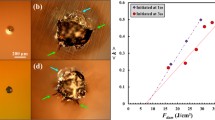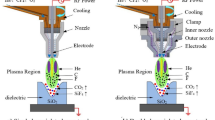Abstract
The threat of cascading damage to downstream components caused by the light modulation intensification of laser repaired morphology on the surface of fused silica optics cannot be ignored in high-power laser systems. This paper uses the angular spectrum diffraction theory based on the analysis of repaired surface morphology of CO2 laser rapid ablation mitigation to study the influence of different repaired morphologies on the downstream 355 nm laser transmission. Studies show that the arc-shaped laser processing lines on the repaired surface are formed by the residual height superposition of the material after laser scanning of two adjacent layers, and the short-pulse laser can substantially suppress the heat-affected zone of the repaired area. The off-axis ring caustic and on-axis hotspot are sequentially generated in the downstream modulated light fields of the conical repaired sites with different diameters. A secondary peak with modulation larger than 3 emerges downstream of the modulation curve. Meanwhile, the maximum modulation and the secondary peak increase with the diameter and cone angle of the repaired site, and the position of the secondary peak appears farther away from the rear surface. The modulations of three repaired sites with cone angles of 15°, 20°, and 25° can finally be stabilized below 3. Overall, the downstream optics should be installed far away from the positions where the maximum modulation and the secondary peak emerge. Additionally, the maximum value and the secondary peak of the downstream light modulation of double repaired sites are larger than that of the single repaired site, and both rise as the repaired sizes increase. Thus, large-scale and large-size repairing of multiple surface damages in the same area should be avoided in the laser repairing of fused silica.
Similar content being viewed by others
References
Matthews M J, Yang S T, Shen N, et al. Micro-shaping, polishing, and damage repair of fused silica surfaces using focused infrared laser beams. Adv Eng Mater, 2015, 17: 247–252
Doualle T, Gallais L, Monneret S, et al. Development of a laser damage growth mitigation process, based on CO2 laser micro processing, for the Laser MegaJoule fused silica optics. Proc SPIE, 2016, 10014: 1001407
Zheng W, Wei X, Zhu Q, et al. Laser performance of the SG-III laser facility. High Pow Laser Sci Eng, 2016, 4: e21
Rubenchik A M, Feit M D. Initiation, growth, and mitigation of UV-laser-induced damage in fused silica. Proc SPIE, 2002, 4679: 79–96
Negres R A, Abdulla G M, Cross D A, et al. Probability of growth of small damage sites on the exit surface of fused silica optics. Opt Express, 2012, 20: 13030–13039
Negres R A, Norton M A, Cross D A, et al. Growth behavior of laser-induced damage on fused silica optics under UV, ns laser irradiation. Opt Express, 2010, 18: 19966–19976
Spaeth M L, Wegner P J, Suratwala T I, et al. Optics recycle loop strategy for NIF operations above UV laser-induced damage threshold. Fusion Sci Tech, 2016, 69: 265–294
Bass I L, Guss G M, Nostrand M J, et al. An improved method of mitigating laser-induced surface damage growth in fused silica using a rastered pulsed CO2 laser. Proc SPIE, 2010, 7842: 784220
Doualle T, Gallais L, Monneret S, et al. CO2 laser microprocessing for laser damage growth mitigation of fused silica optics. Opt Eng, 2016, 56: 011022
Folta J, Nostrand M, Honig J, et al. Mitigation of laser damage on national ignition facility optics in volume production. Proc SPIE, 2013, 8885: 88850Z
Matthews M J, Bass I L, Guss G M, et al. Downstream intensification effects associated with CO2 laser mitigation of fused silica. Proc SPIE, 2008, 6720: 67200A
Yang H, Cheng J, Liu Z, et al. Potential damage threats to downstream optics caused by Gaussian mitigation pits on rear KDP surface. High Pow Laser Sci Eng, 2020, 8: e37
Feigenbaum E, Elhadj S, Matthews M J. Light scattering from laser induced pit ensembles on high power laser optics. Opt Express, 2015, 23: 10589–10597
Feigenbaum E, Nielsen N, Matthews M J. Measurement of optical scattered power from laser-induced shallow pits on silica. Appl Opt, 2015, 54: 8554–8560
Tan C, Zhao L, Chen M, et al. Experimental and theoretical investigation of localized CO2 laser interaction with fused silica during the process of surface damage mitigation. Results Phys, 2020, 16: 102936
Dai W, Xiang X, Jiang Y, et al. Surface evolution and laser damage resistance of CO2 laser irradiated area of fused silica. Optics Lasers Eng, 2011, 49: 273–280
Bai Y, Zhang L, Wei L, et al. Study of downstream light intensity modulation induced by mitigated damage pits of fused silica using numerical simulation and experimental measurements. Acta Phys Sin, 2016, 65: 024205
Guss G, Bass I, Draggoo V, et al. Mitigation of growth of laser initiated surface damage in fused silica using a 4.6-micron wavelength laser. Proc SPIE, 2007, 6403: 64030M
Li B, Zhou Q, Jiang Y, et al. Optical modulation study of repaired damage morphologies of fused silica by scalar diffraction theory. Opt Eng, 2017, 56: 016113
Zheng Y, Ma P, Li H, et al. Studies on transmitted beam modulation effect from laser induced damage on fused silica optics. Opt Express, 2013, 21: 16605–16614
Bourgeade A, Donval T, Gallais L, et al. Modeling surface defects in fused silica optics for laser wave propagation. J Opt Soc Am B, 2015, 32: 655–663
Tournemenne F, Bouillet S, Rouyer C, et al. Strong light intensifications yielded by arbitrary defects: Fresnel diffraction theory applied to a set of opaque disks. Phys Rev Appl, 2019, 11: 034008
Yang H, Cheng J, Liu Z, et al. Application of light diffraction theory to qualify the downstream light field modulation property of mitigated KDP crystals. Optics Laser Tech, 2021, 138: 106873
Galeener F L, Barrio R A, Martinez E, et al. Vibrational decoupling of rings in amorphous solids. Phys Rev Lett, 1984, 53: 2429–2432
Yang H, Cheng J, Chen M J, et al. Downstream light intensification induced by Gaussian mitigation pits using micro-milling on rear KDP surface. Proc SPIE, 2019, 10840: 108400W
Zhu C, Liang L, Yuan H, et al. Investigation of stress wave and damage morphology growth generated by laser-induced damage on rear surface of fused silica. Opt Express, 2020, 28: 3942–3951
Li J C. Diffraction Calculation and Digital Holography (in Chinese). Beijing: Science Press, 2014
Yang H, Cheng J, Liu Z, et al. Secondary peak of downstream light field modulation caused by Gaussian mitigation pits on the rear KDP surface. Opt Express, 2020, 28: 28479–28490
Li J, Yuan C, Tankam P, et al. The calculation research of classical diffraction formulas in convolution form. Optics Commun, 2011, 284: 3202–3206
Born M, Wolf E. Principles of Optics: Electromagnetic Theory of Propagation, Interference and Diffraction of Light. New York: Elsevier, 2013
Wolfe C, Kozlowski M, Campbell J, et al. Laser conditioning of optical thin films. Laser Induced Damage Opt Mater, 1990, 1438:143810
Zhang C, Zhang L, Jiang X, et al. Influence of pulse length on heat affected zones of evaporatively-mitigated damages of fused silica optics by CO2 laser. Optics Lasers Eng, 2020, 125: 105857
Wong J, Ferriera J L, Lindsey E F, et al. Morphology and microstructure in fused silica induced by high fluence ultraviolet 3ω (355nm) laser pulses. J Non-Crystalline Solids, 2006, 352: 255–272
Tan C, Zhao L J, Chen M J, et al. Optical modulation of repaired damage site on fused silica produced by CO2 laser rapid ablation mitigation. Chin Phys B, 2020, 29: 54209
Author information
Authors and Affiliations
Corresponding author
Additional information
This work was supported by the National Natural Science Foundation of China (Grant Nos. 51775147 and 52175389), the Consolidation Program for Fundamental Research (Grant No. 2019JCJQZDXX00), the Science Challenge Project (Grant No. TZ2016006-0503-01), the Young Elite Scientists Sponsorship Program by CAST (Grant No. 2018QNRC001), the Natural Science Foundation of Heilongjiang Province (Grant No. YQ2021E021), the China Postdoctoral Science Foundation (Grant No. 2018T110288), the Self-Planned Task of State Key Laboratory of Robotics and System (HIT) of China (Grant Nos. SKLRS201718A and SKLRS201803B), the Science and Technology Research Program of Chongqing Municipal Education Commission (Grant No. KJQN201800623), and the China Scholarship Council (Grant No. 202006120158).
Rights and permissions
About this article
Cite this article
Tan, C., Zhao, L., Chen, M. et al. Repaired morphology of CO2 laser rapid ablation mitigation of fused silica and its influence on downstream light modulation. Sci. China Technol. Sci. 65, 1116–1126 (2022). https://doi.org/10.1007/s11431-021-2007-2
Received:
Accepted:
Published:
Issue Date:
DOI: https://doi.org/10.1007/s11431-021-2007-2




